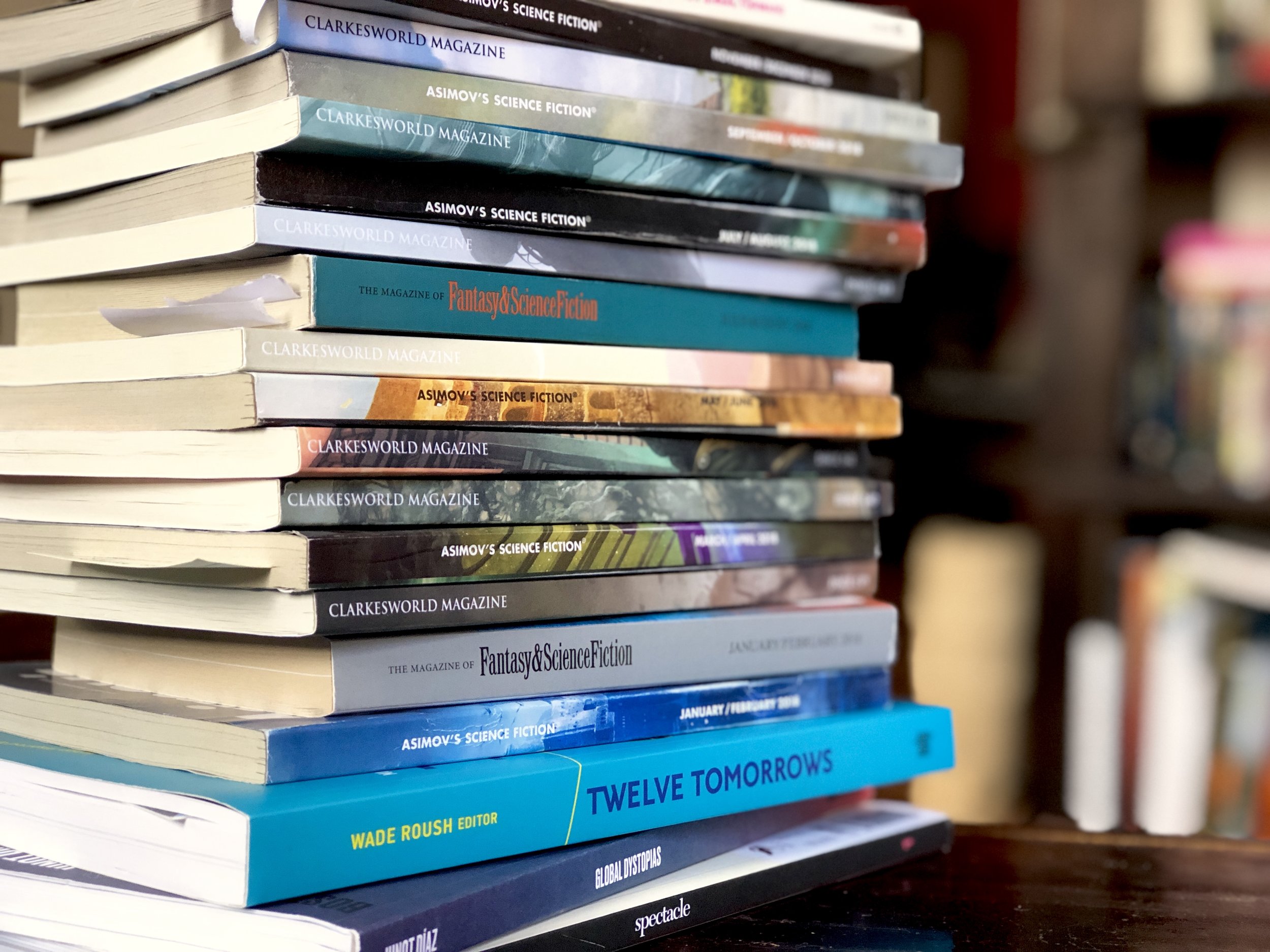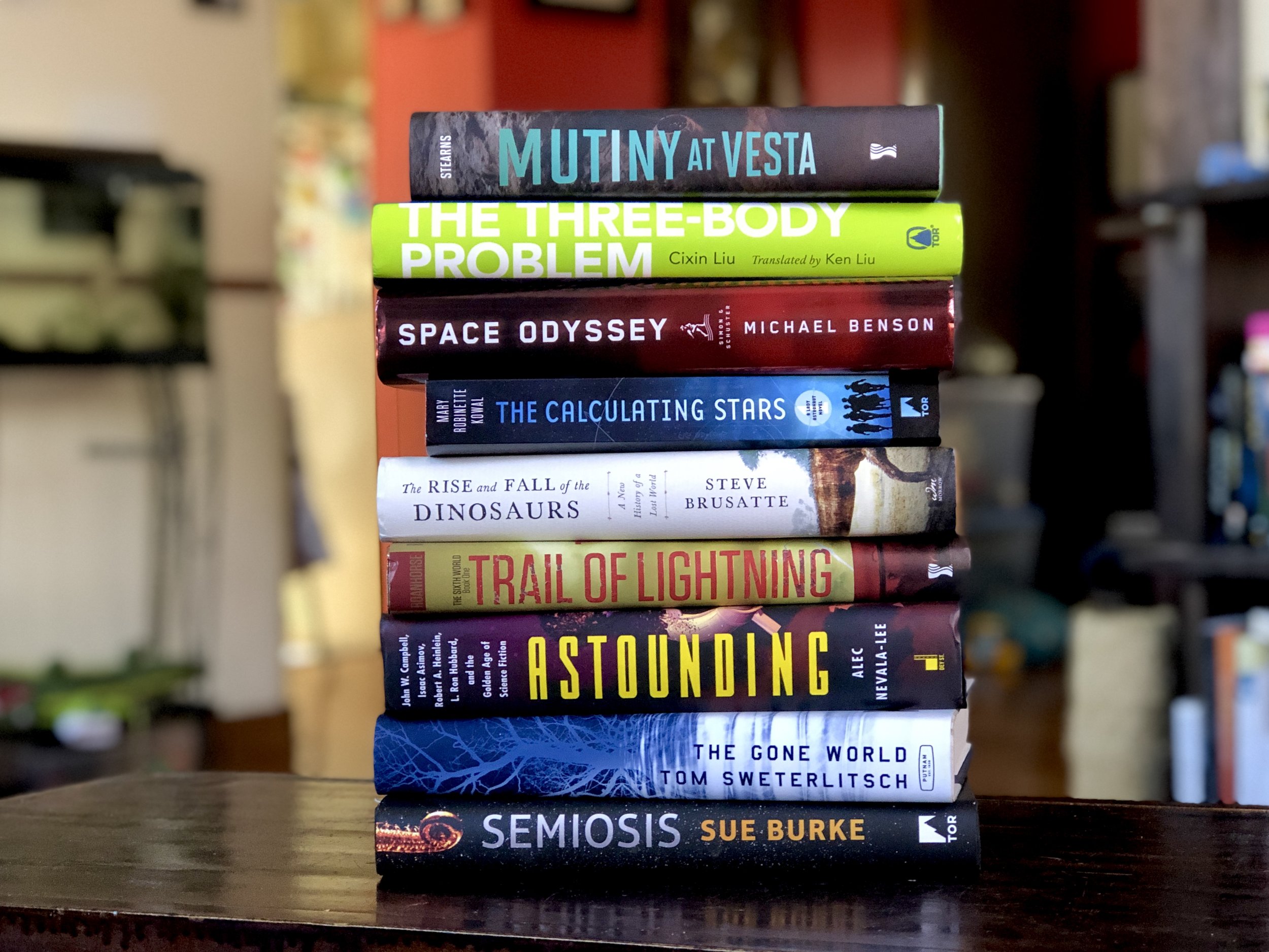This year, I decided to stop complaining that I didn’t pick up enough short fiction and ended up … actually carving out time to read stories over the course of the year. I kept track via an ongoing Twitter thread, as well as on my Facebook page, which I think was a good way to keep myself on track, for the most part.
I kept track of what I read on a Twitter thread and on Facebook, but not everything survived my purge of Twitter earlier this fall (I’m missing a couple, sadly). Here’s the mostly full list:
Artisanal Trucking, LLC, by Mary Robinette Kowal, Asimov’s Science Fiction, March / April 2018
Mother Tongues by S. Qiouyi Lu, Asimov's Science Fiction, January / February 2018.
Barren Isle, by Allen M. Steele, Asimov's Science Fiction, January / February 2018.
Birth of the Ants Rights Movement, by Annalee Newitz, Spectacle Magazine, Issue 1.
Emojis, by Rudy Rucker, Asimov's Science Fiction, March / April.
Carouseling, by Rich Larson, Clarkesworld Magazine, Issue 139.
Without Exile by Eleanna Castroianni, Clarkesworld Magazine, Issue 139.
Don’t Press Charges and I won’t Sue, by Charlie Jane Anders, Boston Review’s Global Dystopias.
The Martian Obelisk, by Linda Nagata, Tor.com.
Ingredients, by Craig DeLancey, Spectacle Magazine #1.
Cosmic Spring, by Ken Liu, Lightspeed Magazine, March 2018.
Sanctuary by Allen M. Steele, Tor.com
50 Ways to Leave Your Fairy Lover, by Aimee Picchi, Fireside Fiction, April 2018.
Automated Valor, by August Cole, US Naval Institute’s Proceedings Magazine.
Logistics, by AJ Fitzwater, Clarkesworld Magazine, Issue 139.
Photojournalist, by Mack Reynolds, Analog Science Fact and Fiction, February 1965.
Sunset, by Tobias Buckell, Lightspeed Magazine, May 2018.
Blessings, by Naomi Novik, Uncanny Magazine, May / June 2018.
The Baboon War, by Nnedi Okorafor, Levar Burton Reads.
Not Now, by Chelsea Muzar, Clarkesworld Magazine, Issue 140.
The Vastness, by Bo Balder, Clarkesworld Magazine, Issue 140.
Life from the Sky, by Sue Burke, Asimov’s Science Fiction, May / June 2018.
Mortui Vivos Docent, by Hanting Liang in Spectacle Magazine #1.
Fleeing Oslyge, by Sally Gwylan, Clarkesworld Magazine, Issue 140.
Cold Comfort, by Pat Murphy / Paul Doherty, Clarkesworld Magazine, Issue 140.
What Gentle Women Dare, by Kelly Robsen in Uncanny Magazine, May / June 2018.
Rejuve, by Tina Connolly in Daily Science Fiction, June 12th.
Wings of Earth, by Jiang Bo (Andy Dudak, Translator), Clarkesworld Magazine, Issue 140.
Farewell, Doraemon, by A Que (Translated by Ken Liu / Emily Jin), Clarkesworld Magazine, Issue 140.
Meridian, by Karin Lowachee, Clarkesworld Magazine, Issue 141.
When the Rains Come Back, by Cadwell Turnbull, Asimovs Science Fiction, May / June 2018.
Okay, Glory, by Elizabeth Bear, MIT Technology Review’s Twelve Tomorrows.
The Lady Astronaut of Mars, by Mary Robinette Kowal, Tor.com.
A Space of One’s Own, by Steve Rasnic Tem, Clarkesworld Magazine, Issue 141.
Ephemera by Ian R. McLeod, Asimov’s Science Fiction, July / August 2018.
Gubbinal, by Lavie Tidhar, Clarkesworld Magazine, Issue 142.
Attachment Unavailable by Leah Cypess, Asimov’s Science Fiction, July / August 2018.
Every Hour of Light and Dark by Nancy Kress, Omni Magazine, Winter 2017.
Your Multicolored Life, by Xing He (translated by Andy Dudak), Clarkesworld Magazine, Issue 142.
The Cosmonaut’s Caretaker, by Dora Klindžić, Clarkesworld Magazine, Issue 142.
Starship Mountain by Allen M. Steele, Asimov’s Science Fiction, July / August 2018.
Demons in the Tall Grass, by Mike Matson, Small Wars Journal.
Loss of Signal, by S.B. Divya, Tor.com.
Heron of Earth, by Vajra Chandraseker, Clarkesworld Magazine, Issue 142.
Vault, by D.A. Xiaolin Spires, Clarkesworld Magazine, Issue 142.
The Tale of Three Beautiful Raptor Sisters and the Prince Who Was Made of Meat, by Brooke Bolander, Uncanny Magazine, Issue 23.
The James Machine, by Kate Osias, Clarkesworld Magazine, Issue 143.
The Phobos Experience by Mary Robinette Kowal, The Magazine of Fantasy and Science Fiction, July / August 2018.
The Queen and the Peri Takes Her Time by Corey Flintoff, The Magazine of Fantasy and Science Fiction, July / August 2018.
To Fly Like A Fallen Angel, by Qi Yue (translated by Liz Hanlon), Clarkesworld Magazine, Issue 142.
Red Lizard Brigade, by Sam Miller, Uncanny Magazine, Issue 23.
Water Birds, by G. V. Anderson, Lightspeed Magazine, July 2018.
The Dinosaur Graveyard by Aidan Moher, Robot Dinosaur Fiction.
The Minnesota Diet, by Charlie Jane Anders, Slate.
The Wandering Earth by Cixin Liu, The Wandering Earth.
The Grays of Cestus IV, by Erin Roberts, Asimov’s Science Fiction, September / October 2018.
Octo Heist, by Rich Larson, Clarkesworld Magazine, Issue 146.
The Veilonaut’s Dream by Henry Szabranski, Clarkesworld Magazine, Issue 143.
Nightflyers, George R.R. Martin, Analog Science Fact and Fiction, April 1980.
The Ones Who Stay and Fight by N.K. Jemisin, How Long ‘Til Black Future Month?
The City Born Great, N.K. Jemisin, Tor.com.
The Foodie Federation’s Dinosaur Farm, by Luo Longxiang (Translated by Andy Dudak), Clarkesworld Magazine, Issue 144.
Sparrow, by Yilin Wang, Clarkesworld Magazine, Issue 145.
The Falls: A Luna Story, by Ian McDonald, Clarkesworld Magazine, Issue 145.
Domestic Violence by Madeline Ashby, Slate.
Across the Border by Sahil Lavingia, Vice’s Motherboard.
An Interview with Santa’s Lawyer, by John Scalzi, Whatever.
Real Girls by Laurie Penny, Wired Magazine, January 2019.
The Trustless by Ken Liu, Wired Magazine, January 2019.
Placebo by Charles Yu, Wired Magazine, January 2019.
The Farm by Charlie Jane Anders, Wired Magazine, January 2019.
When Robot and Crow Saved East St. Louis by Annalee Newitz, Slate.
Compulsory by Martha Wells, Wired Magazine, January 2019.
The Reunion by Stanley Chen Quifan (translated by Ken Liu and Emily Jin, MIT Technology Review.









:format(webp):no_upscale()/cdn.vox-cdn.com/uploads/chorus_asset/file/10310465/akrales_171212_2179_0245.jpg)












